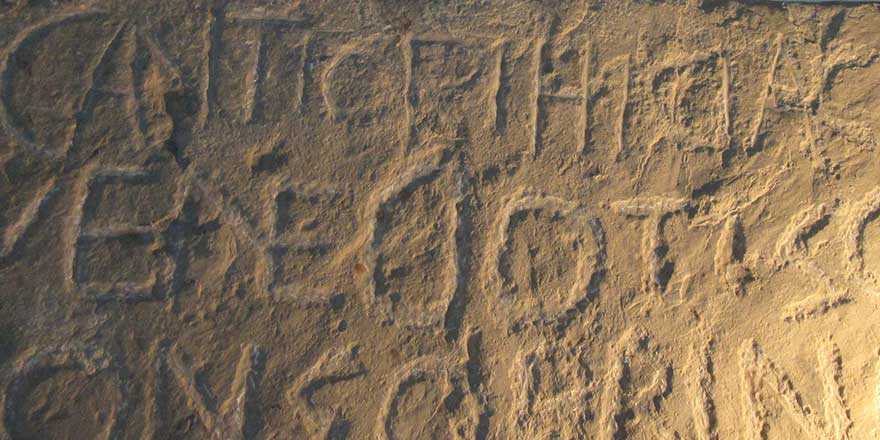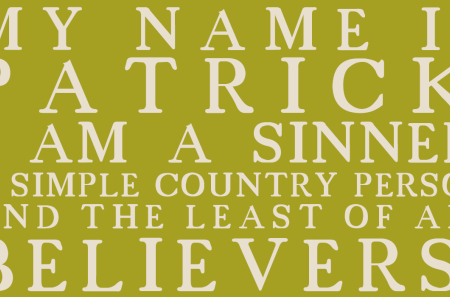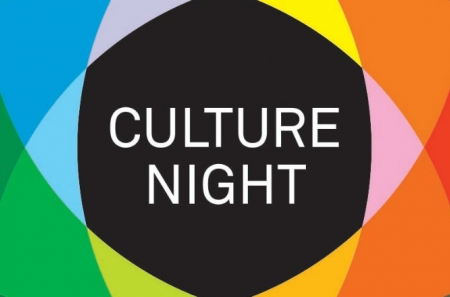
How linguistics can help the historian: Part VII
17 June 2020Downloads
This instalment concludes the series, with an example of linguistics and archaeology working hand in glove to help date a recently discovered pair of Irish-language inscriptions written in the distinctive alphabet known as ogham.
Last week’s instalment of this series outlined how linguistics enables us scientifically to retrieve the original pronunciation of a historical text — even when the sounds of the letters are known to have changed over time. We saw how this can be done by systematically triangulating backwards from the pronunciation of modern tongues that are known to be related to the language of the text in question. Once the pronunciations enshrined in that text have been established in this way, they collectively represent a point whose linguistic coordinates we have thus now been able to fix on the path back to the original tongue; so they can themselves go on to be fed in as data for the further refinement of our picture of the language. The more established pronunciations we can feed in, from different periods, in this iterative fashion, the sharper the focus we can gain on the particular tongue’s historical development.
It’s not just linguistic archaeology — there’s geology too
Applied cumulatively, the back-triangulation method gives us the relative sequence of changes in pronunciation that have happened in any particular language. These will have taken place seamlessly and almost imperceptibly from one generation to the next, probably with the speakers concerned being barely aware of them — after all, provided they are speaking the same language, one can hardly imagine a situation developing in which parents are quite incapable of communicating with their own children (provided both sides want to, that is!) But, whereas changes to pronunciation occur gradually and smoothly, changes to written standards happen abruptly. It is like the movement of tectonic plates in the earth’s crust: they are wedged together, but pressure builds up until it gets released in a sudden movement, namely an earthquake. It was a linguistic earthquake when the linguist scribe in Strasbourg, whom we encountered in Part V, suddenly cast aside the conventions of a thousand‑year‑old Latin spelling system and wrote, using his new French orthography, what was after all only the outcome of an accumulation of tiny changes to the original language. The catalyst, in that case, was the need to write phonetically for the sake of the German ruler. It was really a case of a spelling system that had got stuck being readjusted so as to catch up with the pronunciation of the language being represented. The introduction of the caighdeán orthography was a twentieth-century example of the same thing for Irish — but below we shall see how analogous adjustments to Irish spelling must already have been taking place by the mid‑first millennium of our era.
Now, writers clearly cannot anticipate linguistic changes that have not yet taken place by their time. This means that whenever within a given alphabetic text we find forms of words that are mutually anachronistic, it follows that, at the time the text was executed, the language must have reached at least the developmental stage reflected in the text’s most advanced feature. On the other hand, written standards tend to remain fixed, since writings survive from one generation to another and spelling traditions always grow up sooner or later. So, external influences apart, all other earlier‑looking features of the text must reflect those traditions. In short, any text that displays mutually anachronistic forms must date from at least as late as the latest of them, while the written tradition to which the text belongs must have an origin at least as early as the earliest of them. All other forms in the text will reflect written conventions coined at stages through which the language passed during its development between these dates.
The Liscahane oghams
With those thoughts in mind, it is time to turn to the specific Irish‑language example that closes our series. A few years ago, two new discoveries of large pillar stones were excavated at Liscahane near Millstreet, Co. Cork (they had long ago been recycled for use as the roof of a souterrain). Each of them bore an inscription in the Morse-code-like script called ogham, which is of course the oldest way of representing Irish in writing. Transliterated into normal roman capitals, as is conventional in ogham studies, they came out as
- COLMANN MACI COMGGANN
and
- CROCCAN MAQI DOMONIGART
with each of them, like most oghams, commemorating ‘so-and-so son of so-and-so’ (readers will recognise the word mac ‘son’ in both). At the time, the archaeologist responsible for writing up the report, Barra Ó Donnabháin, contacted the present author to ask whether these transliterations contained any linguistic clues that would help to date the stones. (He also supplied the illustration below, and has kindly given permission for it to be used here.) It was possible to point out in reply that, by the time either inscription was written, the Irish language must have reached at least the stage known as syncope (loss of internal syllables). This was because one shows the name that is now spelled Colmán; this is known to derive from an original Columbanus, and the latter has a vowel between the l and the m. As for the other stone, the giveaway is in the name spelled DOMONIGART. This is recognisably a compound of two elements, the second of which begins with the G symbol; any vowel before the G would have been removed by syncope. We see the symbol for the vowel I in that position, and so at first sight might think that syncope had not yet happened in this inscription. But here we need to be careful …

… because we also see an O symbol between the M and the N. Etymologically, there was never a vowel there: the first element was originally [domno-], as in the name of the famous Gaulish warlord Dumnorix. Linguistic back-triangulation, conducted on a good many examples of words like this, shows that a vowel would only have developed between the M and the N symbols after the vowel before the G had disappeared by syncope and, in fact, in compensation for its loss (it was the only thing that prevented the need to pronounce three consonants in a row, impossible in Celtic.) In conclusion, there can never have been four syllables in the pronunciation of this name; the I symbol is only there by orthographic tradition (like the k in the spelling of English ‘knife’), and syncope has indeed taken place in this inscription too. In that case, symbols representing still earlier stages of the language on either stone — such as the final I on the middle word in each inscription, or the Q instead of C in one of those instances — must be just that: they reflect a knowledge of the tradition of how to spell in ogham, rather than representing sounds as they were in the post‑syncope period when these inscriptions were executed. Like its modern‑day counterpart, the word spelled MACI and MAQI must on each stone already have been monosyllabic in pronunciation, since we know that final syllables had been lost half a century before syncope. And the final consonant in both cases must already have been pronounced as [k] rather than as [q], as the sound [q] had already been replaced by the sound [k] by the time of syncope. Syncope is conventionally dated to c. 550. Linguistics was therefore able to contribute the information that, despite initial appearances, both inscriptions had to be at least that late — either or both might be much later still, but that could not be shown from the evidence of language alone.
So where does all this leave us?
In an e-mail acknowledging the linguistic feedback, Dr Ó Donnabháin kindly commented as follows: ‘Your conclusions are really interesting. I have 2 radiocarbon dates for the construction of the souterrain. One calibrates ... to 430–660 AD while the other is from 650–990 AD. Your conclusions would suggest that the construction would have been at least at the later end of the first date. This fits better with radiocarbon dates from other sites.’ Now, the linguistic analysis had been conducted without knowing that radiocarbon dating had been attempted; so it was particularly congenial to learn that the conclusion it had independently arrived at was in fact fully compatible with that reached by the other approach. But it was interesting to hear the comment of a historian colleague: ‘It’s nice to have the linguistic argument corroborated like that’. This was true, of course; but the question does arise as to why it always tends to be phrased that way round. Why not instead see the conclusions from the archaeological approach as having been corroborated by the linguistic argument? It goes back to an old assumption that people have, very hard to eradicate, that linguistic reasoning can never really do more than suggest some conclusion. In contrast to this, the tendency is to see supposedly more ‘scientific’ data as definitive — including archaeological data. But artefacts themselves need to be interpreted and, whatever about radiocarbon dating, the present series hopes to have shown that linguistic evidence is just as objective and empirical, and sound arguments based on it just as scientific and rational, as the discovery of any physical artefact or the conclusions that may be drawn therefrom. And, that those conclusions can be just as revealing.
Many thanks for having now read the full set of these little contributions. By all means get in touch with the author (A.Harvey@ria.ie), at the Royal Irish Academy’s Dictionary of Celtic Latin project, as feedback is always welcome!
Read the first article in the series here
Read the second article in the series here
Read the third article in the series here
Read the fourth article in the series here
Read the fifth article in the series here
Read the sixth article in the series here
* Main series image: The sub-Roman ‘Venedotis cive’ stone now preserved at Penmachno, North Wales. Until recently the inscription was interpreted as implying that the local kingdom of Gwynedd had taken to issuing its own citizenship in post-imperial times. (Photo by A. Harvey)



